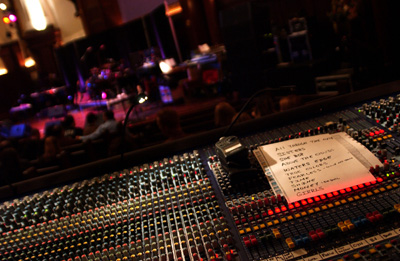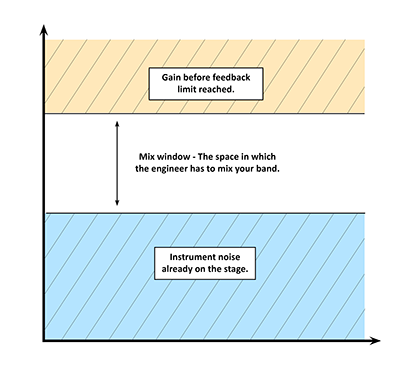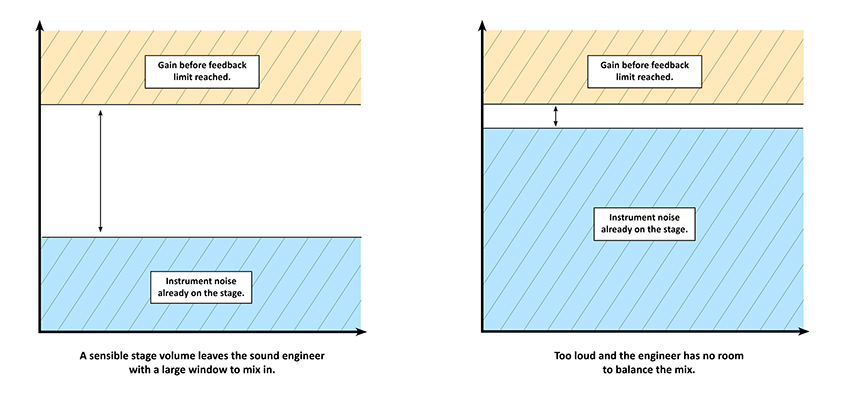Be kind to your sound engineer, help them to help you by giving them a nice big Mix Window to work in. Read on to find out what that is and how to help give your band that Killer Live Sound.

We all hope that, one day, we are fortunate enough to have our band playing on stage at the world’s biggest and best live music venues. Wembley stadium, Glastonbury Festival, Madison Square Garden, The Hollywood Bowl…the list goes on. Getting to perform at these venues almost certainly means you’ve done something right and you and your music are very popular.
However, they also have something else in common. Playing one of these venues means you’re surrounded by the best possible sound and lighting equipment money can buy. In order to make your show seen and heard by audiences of this size, you’ll be playing through a speaker system costing at least 6 figures, quite possibly seven once all of the cabling, mixing desks and other equipment is added to the cost of the actual speakers themselves.
Despite playing to so many people and using such a vast array of equipment, in a lot of ways both you as the performer and whoever is working with you as your sound engineer have a much easier job than you would have in a smaller venue.
Your guitar amp or drumkit is tiny in comparison to the sound system being used, and you can safely turn everything up as loud as you like and play as loud as you like, safe in the knowledge that you’re not really affecting what the sound engineer is doing with your mix. He has so much headroom above your stage volume on his massive PA that he can turn everything up and down as much as he likes and really dial in the mix for you, make your band sound as good as it possibly can.
Oh, to be playing stadiums and festivals…
Here in the real word, for us mere mortals things aren’t so simple. In a normal small (or even heading towards medium) music venue, the stage is much smaller, the PA is much smaller, and the audience is much closer. They can hear your drums and guitar amps, and even stage monitors, clearly. At these kinds of shows, the sound engineer doesn’t have the freedom to just mix the band as they would like, as there is already a lot of sound in the room. He can only add to what is already there with the PA system.
The drums are probably already pretty loud. He will add some kick and toms into the PA so that the subwoofers give them some depth and punch, make them nice and big and full. But he probably won’t add very much of the snare or cymbals, as in a typical bar or club show (unless you have a really quiet drummer) they’re probably already pretty loud.
The guitar and bass guitar amps can be heard by the audience too, to what extent varies depending on how loud the guitarist has turned himself up, but all the sound engineer will be doing is “topping these up”, adding a little extra volume in the PA to bring them into balance with the drums.
However, on the other hand the vocals are one of the quietest instruments on the stage, so the sound engineer will be adding lots of your voice into the PA to bring it into balance with the other instruments. Same with other quiet instruments such as acoustic guitars or electric pianos/keyboards/synths.
The point is that this sound engineer, in many ways, actually has a much harder job to do than the stadium sound engineer. This engineer doesn’t get to start with a (basically) clean slate and mix how he wants, his minimum volume level set by the volume coming from stage, and he has to work with this and slowly add to it, do his best to balance things and bring all the instruments into line together to create a great mix for your band, where everything sounds good and can be heard clearly.
However, as well as having a minimum level of sound already in the room, he also has a maximum level that he can’t go beyond. This will be set at the point where a) everything starts to feedback and you can’t go any louder (click here for an article on understanding feedback and how to avoid it), or b) where it’s simply far too loud and your audience’s ears are bleeding!

Within these two limits, the minimum and maximum, is the engineer’s Mix Window: the space he has to manoeuvre in, to increase the volume of instruments to bring everything into balance and make you sound great.
Now, the maximum part of it, the top line, doesn’t really change much. With some clever use of EQ and a good PA system he can maybe avoid some feedback and raise it by a few db, but at the end of the day you reach a volume where it’s simply uncomfortable to listen to no matter how good the music. The main thing you can change is the bottom of the window, the minimum starting point.
And how do we do this? By carefully controlling our stage volume. The volume on stage has to be loud enough that the sound engineer gets a good, clear signal in the microphones, and so that you can all hear things properly on stage and stay in time with each other. But it should be no louder than that.

You’re not at a rock show, your audience is. They should have crystal clear sound and should be able to hear things perfectly, and that’s probably going to take a little sacrifice on your part, to not have things as loud as you would like. I know it feels great to have everything cranked on stage, and because that’s what you’ve been doing in the rehearsal room it feels like something is missing on stage when you don’t do that, you’re not getting the same feel you’re used to. But it’s a sacrifice you’re probably going to have to make just now.
Once you’re playing stadium shows you’ll be able to turn everything up as loud as you like, hell I’ll even come along and turn it up for you! But until then, while you’re still playing in smaller bars, clubs and halls trying to build your audience, work with your sound engineer and think carefully about your stage volume.
It’ll be the best thing you can do to achieve that Killer Live Sound.
